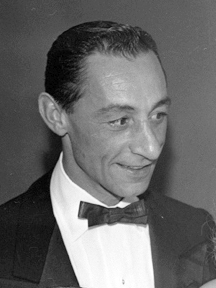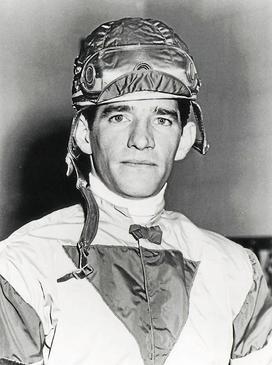Related Research Articles

George Edward Arcaro, was an American Thoroughbred horse racing Hall of Fame jockey who won more American classic races than any other jockey in history and is the only rider to have won the U.S. Triple Crown twice. He is widely regarded as one of the greatest jockeys in the history of American Thoroughbred horse racing. Arcaro was born in Cincinnati, Ohio, the son of an impoverished taxi driver. His parents, Pasquale and Josephine, were Italian immigrants and his father held a number of jobs, including taxi driver and operator of an illegal liquor enterprise during Prohibition. Arcaro was born prematurely, and weighed just three pounds at birth; because of this, he was smaller than his classmates and was rejected when he tried out for a spot on a baseball team. His full height would reach just five-foot, two inches. Eventually nicknamed "Banana Nose" by his confreres, Arcaro won his first race in 1932 at the Agua Caliente racetrack in Tijuana, Mexico; he was 16 years old. In 1934, the inaugural year of Narragansett Park, Arcaro was a comparative unknown who rode many of his early career races at 'Gansett.

Whirlaway was a champion American Thoroughbred racehorse who is the fifth winner of the American Triple Crown. He also won the Travers Stakes after his Triple Crown sweep to become the first and only horse to win all four races.
The Pimlico Special is a Grade 3 American thoroughbred horse race for horses age three and older over a distance of 1+3⁄16 miles held at Pimlico Race Course in Baltimore, Maryland in mid May. The race currently offers a purse of $300,000.
The Comely Stakes is an American Thoroughbred horse race held annually at Aqueduct Racetrack in Queens, New York. Open to three year old fillies, it is raced on dirt over a distance of one mile. The Grade III event offers a purse of $200,000.

The George E. Mitchell Black-Eyed Susan Stakes is a Grade II American Thoroughbred horse race for three-year-old fillies run over a distance of 1+1⁄8 miles on the dirt annually at Pimlico Race Course in Baltimore, Maryland. The event currently offers a purse of $250,000
Challedon (1936–1958) was an American Hall of Fame Champion Thoroughbred racehorse. Bred in Maryland by William L. Brann and Robert S. Castle, he raced under the colors of their Branncastle Farm.
Alfred Masson Robertson was a Hall of Fame jockey in American Thoroughbred horse racing.

Manuel Ycaza was a Panamanian American jockey who led the way for Latin American jockeys in the United States.
Bold Venture, was an American Thoroughbred racehorse that won the Kentucky Derby and Preakness Stakes.
Gregory Duncan "Don" Cameron was an American Thoroughbred horse trainer who trained Count Fleet, who won the U.S. Triple Crown in 1943.
Andrew Schuttinger was an American jockey, trainer and owner in the sport of thoroughbred horse racing. A highly successful jockey, Andy Schuttinger won numerous important races including the Travers Stakes, Jockey Club Gold Cup, and what would become the second leg of the U.S. Triple Crown series, the Preakness Stakes. Among the many top horses he rode was Man o' War, as well as two-time American Champion Filly, Milkmaid, the 1914 American Horse of the Year and a Hall of Fame inductee, Roamer, and another Horse of the Year in 1917, Old Rosebud,
Thomas J. Healey was an American Thoroughbred horse racing Hall of Fame trainer.
My Dear Girl was an American Champion Thoroughbred racehorse.
Carroll M. Bierman was an American Thoroughbred horse racing jockey born in Centralia, Illinois. In 1940, he won the Kentucky Derby on Gallahadion in an upset over heavily favored Bimelech. That Derby ride is considered one of the best by a jockey in America's great race. Gallahadion paid $72.40 on a $2 bet for winning the "Run for the Roses" in the colors of Ethel V. Mars, of the Mars Candy fortune. He rode in the Kentucky Derby four times and finished 3rd, 4th, and 6th in the other three. He also won the 1939 Santa Anita Derby aboard the filly Ciencia.
The FTBOA Florida Sire Stakes My Dear Girl division is a Thoroughbred horse race run annually at Gulfstream Park, in Hallandale Beach, Florida for two-year-old fillies by FTBOA registered stallions at a distance of a mile and a sixteenth on dirt. It is part of the eleven-race Florida Thoroughbred Breeders' & Owners' Association (FTBOA) Florida Sire series of which seven races are hosted by Gulfstream Park and four by Tampa Bay Downs.
Louis J. Schaefer was an American jockey and trainer in Thoroughbred horse racing best known for winning the Preakness Stakes, second leg of the U.S. Triple Crown series, both as a jockey and as a trainer.
Lester Anthony Balaski was an American Thoroughbred horse racing jockey, a soldier who served his country during World War II, and a founding director and a First Vice-President of the Jockeys' Guild who died as a result of injuries suffered in an August 22, 1964, racing accident at Agua Caliente Racetrack in Mexico. A resident of Chula Vista, California, he had been transported from the racetrack to Mercy Hospital in San Diego, California where he died ten days later.
Scott Paul Harlan was an American National Champion Thoroughbred racehorse trainer and owner of Idle Dell Farm near Hatboro, Pennsylvania.
The Marguerite Stakes was a Thoroughbred horse race at Pimlico Race Course, in Baltimore, Maryland run between 1945 and 1965. A race on dirt for two-year-old fillies, it was created as a companion event to the Pimlico Futurity and declared at the time to be one of the richest of its kind in the United States. It was named in honor of Marguerite, one of the great broodmares in racing history. Marguerite was the dam of four significant runners including Triple Crown winner and U.S. Racing Hall of Fame inductee, Gallant Fox.
The Chesapeake Stakes was an important American Thoroughbred horse race for three-year-old horses of either sex contested on dirt over a distance of a mile and one-sixteenth at Havre de Grace Racetrack in Havre de Grace, Maryland. Run from 1920 until the track closed after the 1950 edition, the race usually run in late April race was a last major prep before the Kentucky Derby. For owners who had not nominated their horse for the Derby it was a chance to test their horse's ability against some of the best three-year-olds in the country, a number of which they would undoubtedly encounter in the ensuing Preakness Stakes.
References
- ↑ Jockeys' Guild History Retrieved August 8, 2018
- ↑ BloodHorse May 18, 2017 article titled "Look Back: Maryland-Bred Challedon Wins 1939 Preakness" Retrieved September 4, 2018
- ↑ New York State Library record of The Hastings News (Hastings-on-Hudson, New York) May 28, 1942 page 3 article titled "Wife of Hastings Jockey Gets Jitters In Close Race" Retrieved August 8, 2018
- ↑ Avalyn Hunter's American Classic Pedigrees for My Dear Girl, Retrieved August 26, 2018